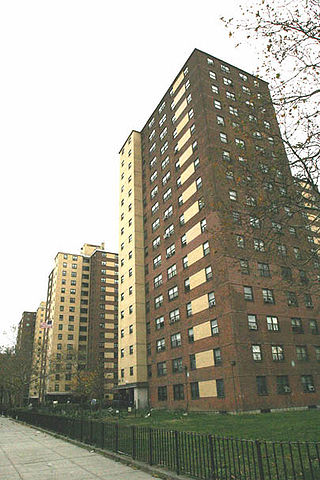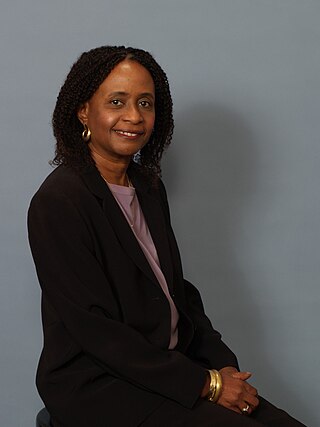Related Research Articles
African-American English is the set of English sociolects spoken by most Black people in the United States and many in Canada; most commonly, it refers to a dialect continuum ranging from African-American Vernacular English to a more standard American English. Like other widely spoken languages, African-American English shows variation stylistically, generationally, geographically, in rural versus urban characteristics, in vernacular versus standard registers, etc. There has been a significant body of African-American literature and oral tradition for centuries.

Brownsville is a residential neighborhood in eastern Brooklyn in New York City. The neighborhood is generally bordered by Crown Heights to the northwest; Bedford–Stuyvesant and Cypress Hills to the north; East New York to the east; Canarsie to the south; and East Flatbush to the west.

The Black Power movement was a branch or counterculture within the civil rights movement of the United States, reacting against its more moderate, mainstream, or incremental tendencies and motivated by a desire for safety and self-sufficiency that was not available inside redlined African American neighborhoods. Black Power activists founded black-owned bookstores, food cooperatives, farms, media, printing presses, schools, clinics and ambulance services. The international impact of the movement includes the Black Power Revolution in Trinidad and Tobago.

Bedford–Stuyvesant, colloquially known as Bed–Stuy, is a neighborhood in the northern section of the New York City borough of Brooklyn. Bedford–Stuyvesant is bordered by Flushing Avenue to the north, Classon Avenue to the west, Broadway to the east, and Atlantic Avenue to the south. The main shopping street, Fulton Street runs east–west the length of the neighborhood and intersects high-traffic north–south streets including Bedford Avenue, Nostrand Avenue, and Stuyvesant Avenue. Bedford–Stuyvesant contains four smaller neighborhoods: Bedford, Stuyvesant Heights, Ocean Hill, and Weeksville. Part of Clinton Hill was once considered part of Bedford–Stuyvesant.

Ocean Hill is a subsection of Bedford–Stuyvesant in the New York City borough of Brooklyn. The neighborhood is part of Brooklyn Community Board 16 and was founded in 1890. The ZIP code for the neighborhood is 11233. Ocean Hill's boundaries start from Broadway and the neighborhood of Bushwick in the north, Ralph Avenue and the neighborhoods of Bedford-Stuyvesant proper and Crown Heights to the west, East New York Avenue and the neighborhood of Brownsville to the south, and Van Sinderen Avenue and the neighborhood of East New York to the east.

John Russell Rickford is a Guyanese–American academic and author. Rickford is the J. E. Wallace Sterling Professor of Linguistics and the Humanities at Stanford University's Department of Linguistics and the Stanford Graduate School of Education, where he has taught since 1980. His book Spoken Soul: The Story of Black English, which he wrote together with his son, Russell J. Rickford, won the American Book Award in 2000.
The demographics of Brooklyn reveal a very diverse borough of New York City and a melting pot for many cultures, like the city itself. Since 2010, the population of Brooklyn was estimated by the Census Bureau to have increased 3.5% to 2,592,149 as of 2013, representing 30.8% of New York City's population, 33.5% of Long Island's population, and 13.2% of New York State's population. If the boroughs of New York City were separate cities, Brooklyn would be the third largest city in the United States after Los Angeles and Chicago.

The New York City teachers' strike of 1968 was a months-long confrontation between the new community-controlled school board in the largely black Ocean Hill–Brownsville neighborhoods of Brooklyn and New York City's United Federation of Teachers. It began with a one day walkout in the Ocean Hill-Brownsville school district. It escalated to a citywide strike in September of that year, shutting down the public schools for a total of 36 days and increasing racial tensions between Blacks and Jews.
"Where We At" Black Women Artists, Inc. (WWA) was a collective of Black women artists affiliated with the Black Arts Movement of the 1960s and 1970s. It included artists such as Dindga McCannon, Kay Brown, Faith Ringgold, Carol Blank, Jerri Crooks, Charlotte Kâ (Richardson), and Gylbert Coker. Where We At was formed in the spring of 1971, in the wake of an exhibition of the same name organized by 14 Black women artists at the Acts of Art Gallery in Greenwich Village. Themes such as the unity of the Black family, Black female independence and embodiment, Black male-female relationships, contemporary social conditions, and African traditions were central to the work of the WWA artists. The group was intended to serve as a source of empowerment for African-American women, providing a means for them to control their self-representation and to explore issues of Black women's sensibility and aesthetics. Like AfriCobra, a Chicago-based Black Arts group, the WWA was active in fostering art within the African-American community and using it as a tool of awareness and liberation. The group organized workshops in schools, jails and prisons, hospitals, and cultural centers, as well as art classes for youth in their communities.

Dindga McCannon, born July 31, 1947, is an African-American artist, fiber artist, muralist, teacher author and illustrator.

Otto Neals is an American painter and sculptor. Originally from South Carolina, he came to New York at four years old and began painting as a child. He spent most of his career working as an illustrator at the Brooklyn Post Office and pursued independent art projects in his spare time. Still residing in Crown Heights, Brooklyn in his nineties, Neals continues to create art full-time as he has done for over 76 years. Although he works out of his basement, he prefers his backyard when weather permits.
Emmett Wigglesworth is a muralist, painter, sculptor, fabric designer, poet and civil rights activist from Philadelphia, Pennsylvania. He has resided in New York since 1958. Wigglesworth is known for his abstract and colorful murals that he says are inspired by his own cultural heritage and life experience.
Weusi Artist Collective is an organization of African-American artists, established in 1965, based in the Harlem section of New York City. Inspired by the Black Arts Movement, the members of the Weusi Artist Collective create art invoking African themes and symbols. The organization was a major driving force behind the development, production and dissemination of black art in the United States in the 1960s and 1970s.
Rasu Jilani is an independent curator, social sculptor, and an entrepreneur whose work is to investigate the intersection between art, culture and civic engagement as a means of raising critical consciousness. The objective of his work is to activate interaction between artists, the local community and the wider public in order to promote awareness around social issues through exhibitions, humanities, community programs, and cultural events.
Reconnection to Learning, better known as the Bundy Report, was a proposal to decentralize New York City schools in the late 1960s.
Nairobi College was a small radical left junior college in East Palo Alto, California for ethnic minority students in the late 1960s.
Jitu Weusi was an American educator, education advocate, author, a community leader, writer, activist, mentor, jazz and art program promoter. He is one of the founders of the National Black United Front, Jitu Weusi Institute for Development, and the International African Arts Festival. The festival started in 1971.
Kwasi Konadu is an author, scholar, educator, writer, editor, and historian.

Brenda M. Greene, is an American scholar, author, literary activist, and radio host at Medgar Evers College of the City University of New York. Greene is also the founder and executive director of the Center for Black Literature, the director of the National Black Writers Conference, and the former chair of the English department at Medgar Evers College. Prior to her work in the academy, Greene also worked as an educator in the New York City Public School system, and with civic and political organizations, to enrich and engage the community-at-large. Since 2004, she has served as a radio host on WNYE radio, connecting listeners to some of today's most accomplished writers. She is the former board chair of the Nkiru Center for Education and Culture, co-founded by hip hop icons Yasiin Bey and Talib Kweli.
William "Bill" Lowell Howell was a graphic designer, painter, illustrator, set designer and photographer. He was an early member of the Weusi Artist Collective, a group of artists who helped birth the Black Arts Movement in the 1960s. He was art director for The New Lafayette Theatre in New York and its Black Theater magazine. He co-founded the Pamoja Studio Gallery in New York in 1967.
References
- 1 2 The Cambridge History of African American Literature. Graham, Maryemma., Ward, Jerry Washington. Cambridge, U.K.: Cambridge University Press. 2011. p. 433. ISBN 9780521872171. OCLC 527702733.
{{cite book}}: CS1 maint: others (link) - 1 2 3 4 5 Kwasi., Konadu (2009). A view from the East : black cultural nationalism and education in New York City. Brown, Scot, 1966-, Konadu, Kwasi. (2nd ed.). Syracuse, N.Y.: Syracuse University Press. ISBN 9780815632061. OCLC 759158744.
- 1 2 3 4 "Jitu Weusi Got Mad Soul | Black Star News". www.blackstarnews.com. Retrieved 2018-01-10.
- ↑ Rickford, Russell. "“Our Nation Becoming”: Uhuru Sasa Shule and the Dual Power function of “Black Independent Institutions” in the Black Power Era." Dartmouth College: Avery Center Black Power Conference, 2012. Retrieved 21 December 2017 from http://avery.cofc.edu/wp-content/uploads/2012/08/rickford21.pdf
- ↑ Fondren, Precious (February 11, 2022). "The Center That Shaped Black Life in 1970s Brooklyn". New York Times.